

John Newton, head of PHE’s Health Improvement Directorate, said: “Severely obese children are at risk of developing a number of serious acute and chronic health problems. These children therefore pose a significant concern in terms of their health and well-being, and may require the provision of specialist services.
“Although in relative terms the prevalence of severe obesity is low, in absolute terms this represents a large number of children nationally.”
Severe obesity is a newly introduced indicator in the regular data compiled through the National Child Measurement Programme that measures the height and weight of all Reception (age 4-5) and Year 6 (age 10-11) each year.
The 2016-17 academic year data has just been released and shows that 14,787 Reception year children were classified as ‘severely obese’. Among England’s Year 6 children measured at the same time, there were 22,646 who fell into this category.
Although children in years 1-5 are not measured, it seems reasonable to infer from the new figures that there are currently over 100,000 ‘severely obese’ children at primary schools in England.
Newton added: “Severe obesity prevalence in children has strong associations with ethnic group, deprivation and sex and there is significant variation in prevalence across the country.”
The areas where ‘severe obesity’ was most widely recorded include London, Birmingham and the West Midlands, Lincolnshire, Sheffield, Bradford, Liverpool, Tyneside, County Durham and Copeland in Cumbria.
Overall, the latest figures show that more than three in every four Reception age children are a healthy weight (76.4%), while 13% are overweight and a further 9.6% are obese, of which 2.35% comprise those whose obesity is classified as ‘severe’.
The new Year 6 data records two in every three children are a healthy weight (64.4%), with 14.3% overweight and 20% obese, which includes 4.07% of children whose obesity is classified as ‘severe’.